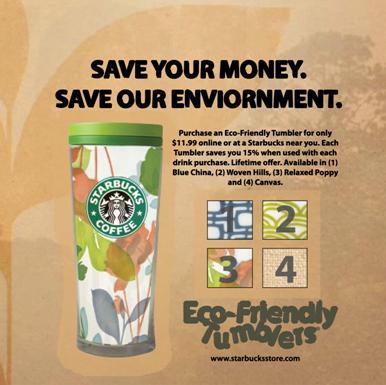This advertisement was created by Starbucks to promote its Eco-friendly Tumblers for its “save your money save the environment campaign”. The ad takes the form of a still image. It reflects environmental consciousness with its Eco-friendly theme. The composition of the advertisement goes in a side-to-side format, where the image of the Tumbler bottle is placed at the left side with the text purchase an Eco-friendly Tumbler for only $11.99 online or at a Starbucks near you, Each Tumbler saves you 15% when used with each drink purchase. Lifetime offers. Available in (1) Blue China, (2) Woven Hills, (3) Relaxed Poppy and (4) Canvas. It also contains the heading SAVE YOUR MONEY. SAVE OUR ENVIRONMENT.
The Eco-friendly theme really stands out because of the light brown color used to symbolize Environmental consciousness. The background of a Tree and a Leaf also helps to really portray the Eco-Friendly theme. The green, brown and grey colors used to design the Tumbler cup in the foreground helps catch the eye of the audience as it makes it stand out but still maintain the theme of the campaign as the Tumbler cup is the largest component on the screen and the center of the campaign.
The message that this advertisement is trying to convey is that if you buy a Tumbler cup you save 15% on drinks and you are essentially saving the environment and the same time which is a win-win for everyone because who doesn’t like to save money and saving the environment also helps preserve life. The implementation of a light shade of brown in the foreground and the use of green, brown and grey to design the Tumbler really bring out the Eco-friendly campaign and helps to further portray Ecological awareness. I do think that the image is effective in reaching it’s target audience because not only does it help attract more coffee lovers who may get their coffee elsewhere but it could also help foster brand loyalty to its existing customers because in as much as some people may not pay close attention to how they are helping saving the planet them purchasing the Tumbler cup helps them to make a conscious effort to save the planet all in the name of getting a good deal for a cup of coffee from Starbucks. Personally, the advert resonates with me quite well because where I’m from a lot of people like to look out for good deals and I’m sure there might be quite a number of people from there who may not be environmentally conscious but a campaign like this is more than helpful in bringing awareness and I think more companies should try to emulate this sort of campaign.
I recognize this company’s brand. it’s a popular coffee shop that’s famous for its wide variety of coffee, drinks, teas, pastries, and other beverages. The company is also recognized for its cozy atmosphere and popular seasonal drinks like the pumpkin spice latte.
According to the article: Is Starbucks greenwashing? A breakdown! by the ethically engineered team. Using a bio-PBS sugar cane liner that is 100% recyclable and compostable, the green Starbucks cup aims to address these issues. They said the prototype “recyclable” does not guarantee that there is a market for it or that it will be recycled. “In the end, recyclables are commodities with the same price volatility as other commodities”.(EE Editorial Team,2024)
The eco-friendly tumblers from Starbucks have sparked debates about whether they represent genuine sustainability efforts or are examples of greenwashing. Critics point out that despite marketing claims, Starbucks might be falling short in truly reducing environmental harm.
Supporters of Starbucks’ tumblers highlight that they are made from recycled materials like PET and coffee grounds, part of a broader initiative to reduce plastic waste. This suggests a genuine attempt by Starbucks to contribute to sustainability, aligning with its goals to lower carbon emissions and promote reusable products (Ethically Engineered,2024) .
However, critics argue that frequent product launches of these tumblers, driven by marketing, could result in waste if customers continue buying new ones instead of reusing existing ones. This cycle, some claim, undermines the environmental benefits the company promotes. Activists have also noted that distributing these tumblers during promotional events might lead to stockpiling rather than practical use, thus contributing to more waste (The Korea Herald,2021).
This article by green that life critiques Starbucks for potentially engaging in greenwashing, raising questions about whether their environmental claims are as substantial as advertised. It argues that while Starbucks promotes its sustainability initiatives—such as reducing disposable cup usage by 50%—the company might be exaggerating or misrepresenting its actual eco-friendly efforts.(Green That Life,2023)
Starbucks have made some changes to their practices in response to consumer feedback and external factors. For instance, when there were concerns raised about the environmental impact of their single-use cups, Starbucks pledged to reduce waste by introducing reusable cups and increasing recycling efforts in their stores. Consumer pressure and public awareness about sustainability issues have influenced Starbucks to take steps towards becoming more eco-friendly. It shows that the company is responsive to feedback and willing to adapt its practices to meet the evolving expectations of its customers and the broader community.
In conclusion, while Starbucks has made efforts to offer eco-friendly alternatives, some see these moves as insufficient or possibly greenwashing, depending on how genuinely the products reduce waste in practice.
Bibliography
EE Editorial Team, “Is Starbucks Greenwashing? A Breakdown!,” Ethically Engineered (blog), January 20, 2024, https://www.ethicallyengineered.com/is-starbucks-greenwashing/.
Sara Goddard, “The Green Starbucks Cup: Green or Greenwashing? – Green That Life,” Green That Life (blog), June 16, 2021, https://greenthatlife.com/green-starbucks-cup-green-or-greenwashing/.


Bhavya Bhola
I like the way you have presented a detailed description and analysis of Starbucks’ marketing for eco-friendly tumblers, focusing on major parts of its environmental messaging and the possibility of greenwashing. You have effectively characterised the ad’s visual aspects, emphasising how the colours, graphics, and positioning of the tumbler complement an environmentally friendly concept. According to me, the assessment of Starbucks’ marketing strategy is balanced and acknowledging both the potential benefits of promoting reusable products and also the argument that such initiatives may be more about profit than actual sustainability.
In terms of greenwashing, you have effectively captured the underlying issue that while Starbucks advertises itself as ecologically responsible, there is doubt regarding the true impact of these programs. You have done a great job in citing scientific sources to back this information up, also that would make any person into doubting that whether Starbucks’ products and efforts actually reduce environmental harm or are simply exaggerated marketing methods. I am impressed by your approach in pointing out that regular product releases and promotional distributions can result in trash, weakening the ad’s eco-friendly claims.
The use of scholarly sources is good, referencing articles from EE Editorial Team and Sara Goddard. You have reflected your knowledge about consumer behaviour, such as whether the audience is swayed by eco-friendly themes or just tempted by bargains. However, the critique could extend deeper into Starbucks’ unique methods for projecting an environmentally responsible image, beyond the tumblers themselves. Your analysis could have also benefited from a more active engagement with such sources, specifically tying them to the claims made against Starbucks’ actions.